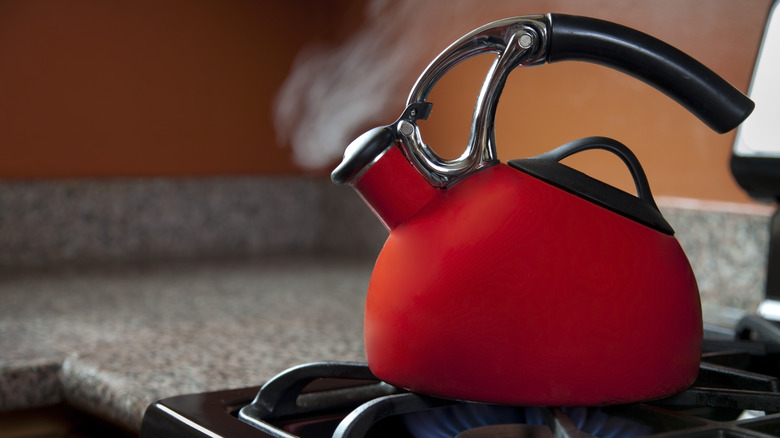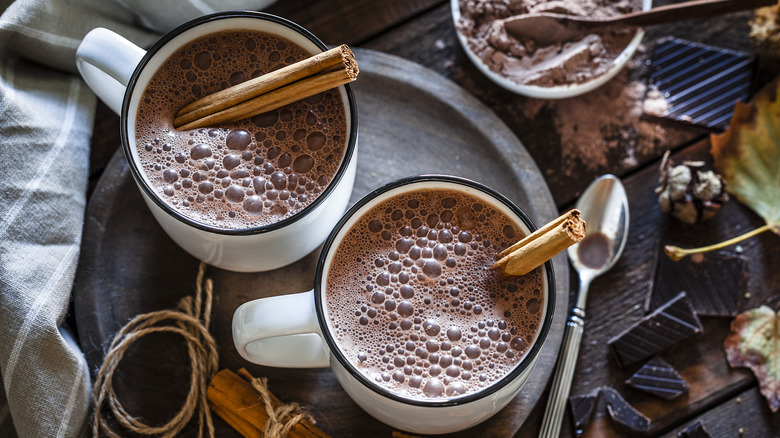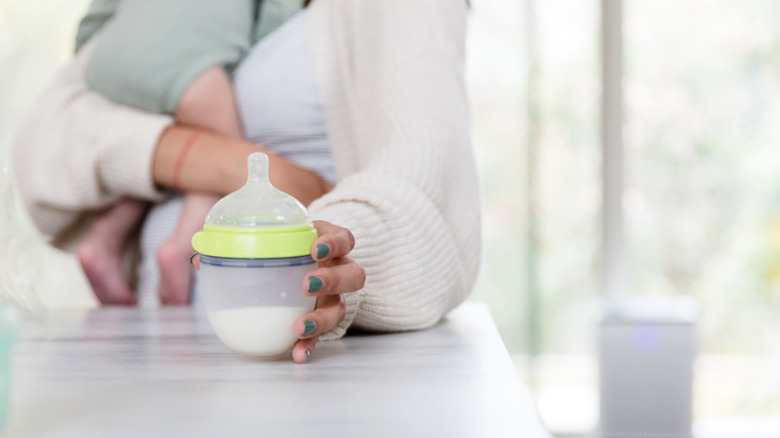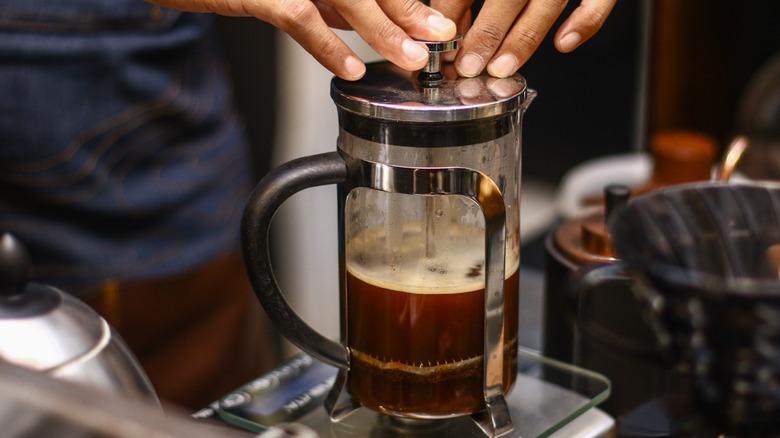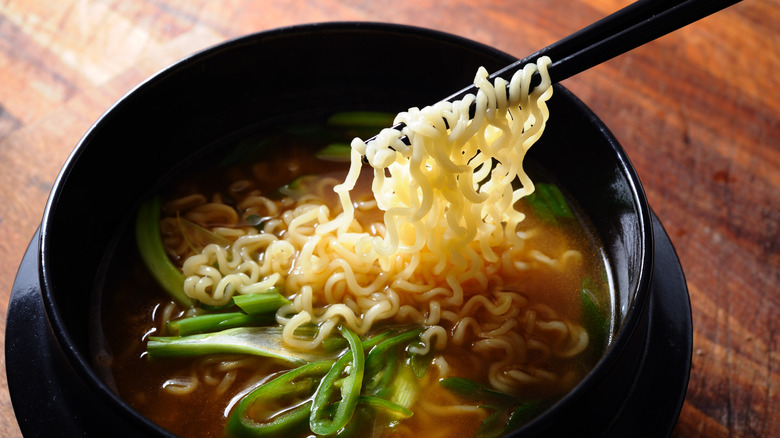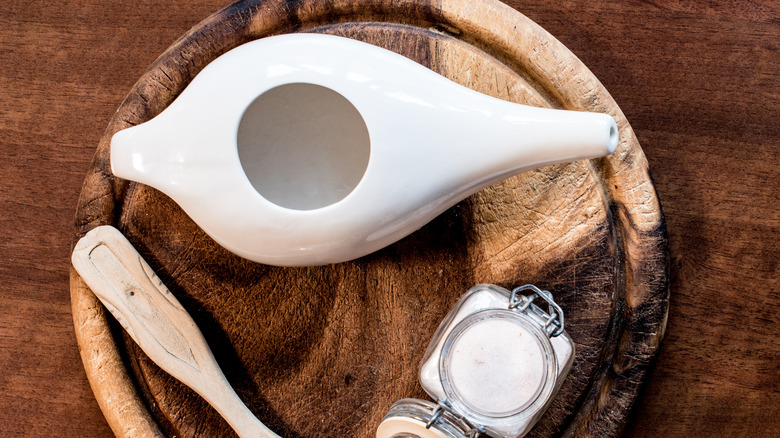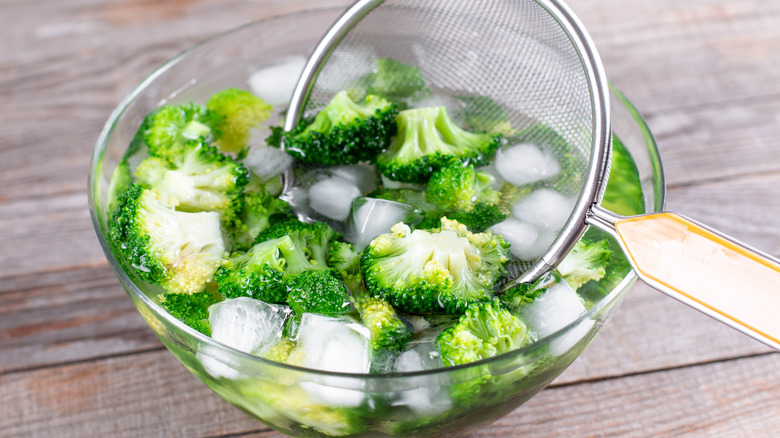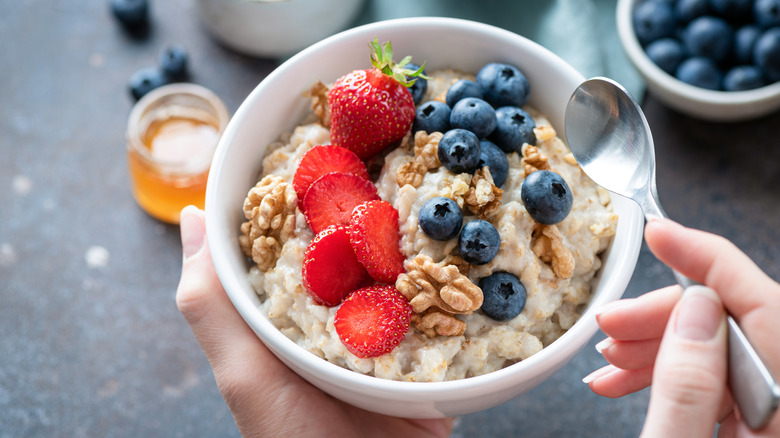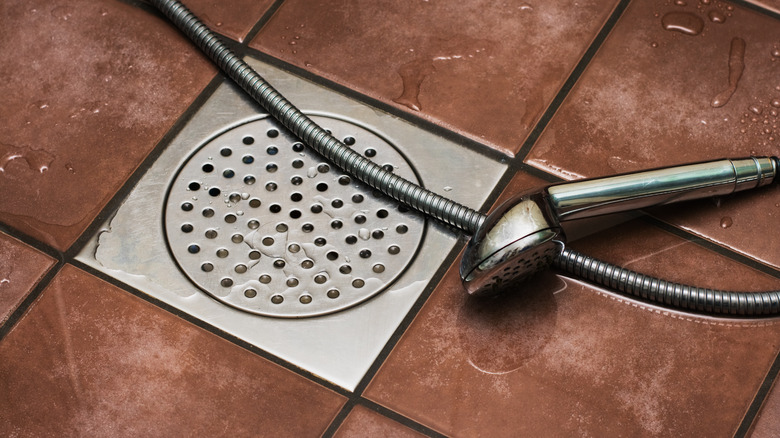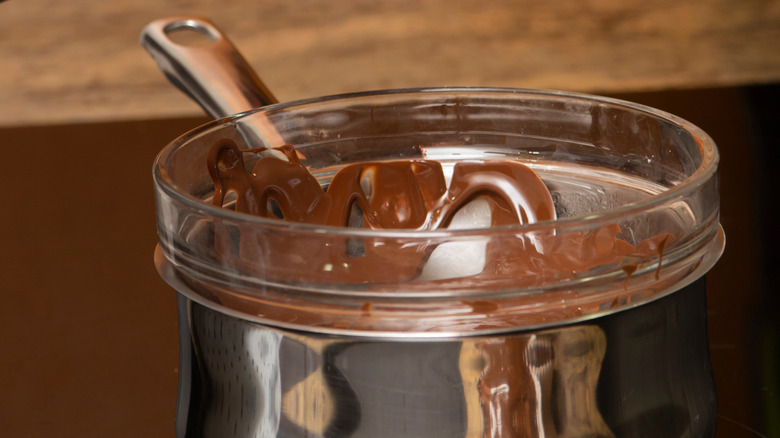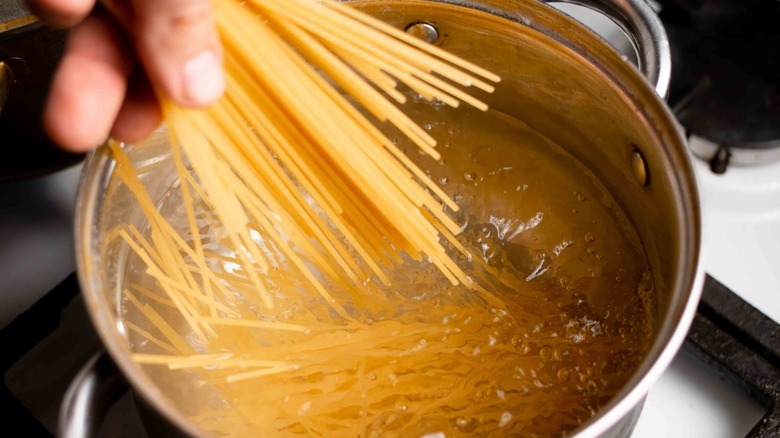10 Best Uses For Your Kettle Beyond Making Tea
We may receive a commission on purchases made from links.
People have been using kettles to boil water since 3500 B.C. The kettle was originally used to render water safe for drinking, but today it's synonymous with tea. It is widely thought that the first cup of tea was brewed in China by accident when leaves fell into a kettle of boiling water that a servant was preparing for the emperor on a windy day. Rather than toss out the water, the emperor, who also happened to be a famed herbalist, chose to drink it — and tea was born.
Kettles have evolved over the last several millennia, from the handmade copper kettles of yesteryear to modern electric kettles that can boil water in minutes (no fire necessary). But, despite centuries of development and modernization, kettle design remains largely unchanged. If it ain't broke, don't fix it.
Kettles are versatile kitchen appliances with a range of uses outside of making a cup of tea. Your kettle can be used to make ramen, melt chocolate, and even unclog a drain. Along with a little personal experience, we scoured the net for articles and inventive blogs to compile this list of 10 unconventional ways to put your kettle to use (no tea required).
1. Make hot chocolate
Put your kettle to good use boiling water for homemade hot chocolate. There's something special about a cup of hot cocoa, and it's so easy to make at home. You can make a hot chocolate mix from scratch using your favorite recipe or choose from one of these store-bought hot chocolate mixes to have a cup of cocoa ready in no time.
Whipping up a batch of DIY hot chocolate mix is surprisingly easy (and delicious). Many recipes include dry milk, heavy cream powder or powdered coffee creamer, confectioners' sugar, and cocoa powder. If you don't already have these ingredients around the house (dried milk and cream powder aren't as popular as they used to be), they are relatively inexpensive and easy to find.
To make a comforting cup of cocoa, bring your kettle to a boil and get your preferred hot chocolate mix ready. Once your water has boiled, fill your favorite mug with the mixture according to recipe directions (usually about ⅓ of the way full). Pour the hot water over the mixture. Stir, let cool, and enjoy. Don't forget to drop a couple of marshmallows or a cinnamon stick in for added flavor and presentation.
The fun part about making hot chocolate at home is that you can tweak the ingredients to make it how you like it. Some people even put cheese in their hot chocolate (the phrase "don't knock it 'till you tried it" comes to mind).
2. Warm baby bottles
The baby product industry would love to convince you that the only proper way to warm up a baby bottle is with a specialized (and expensive) baby bottle warmer, but the versatile kettle is the perfect tool. This tried-and-true method is a favorite amongst tired parents, and you'll use the kettle for years after the baby has outgrown bottles (you won't be able to say that for a baby bottle warmer).
Modern kettles can come with lots of fun bells and whistles, and if you have a smart kettle with temperature controls and the ability to schedule the start time, you can wake up to perfectly warmed water right when it's time to feed that bottle. Find a container that is larger than your bottle. A bowl or a large mug should do the job. Place the bottle, filled with formula or breastmilk, in the container and fill the container with your water from your kettle – recommended to be about 98 degrees Fahrenheit (or body temperature). Surrounded by hot water, the bottle should warm up within a few minutes.
Always test the bottle before you feed your baby to confirm it's not too hot. You can do this by squirting a few drops on your wrist. If you can't feel it, the liquid is room temperature and safe to feed. It probably goes without saying, but never use a microwave to heat a baby bottle, as it probably won't heat evenly, (per the FDA).
3. Make fancy coffee with a French press
You don't need a traditional coffee maker to enjoy fancy, high-quality coffee at home. There are many ways to make coffee at home, but one of the more popular methods of late involves using a kettle and a French press. Coffee aficionados love the French press because it's plastic-free, doesn't use wasteful filters, and produces a cup of strong flavored coffee.
The French press – created in 1852 in France but later improved upon in Italy – uses coffee grounds, not beans. It works by immersing the grounds in hot water from your kettle. After about four minutes of soaking, press down on the filter to strain out the grounds — although some experts refrain from pressing down and stir the grounds instead before pouring with the filter still up. Either way, you're left with a rich, flavorful cup of coffee. The perfect cup is made with water around 200 degrees Fahrenheit (if it's much hotter than that, it can leave your coffee with a burnt flavor).
4. Cook instant noodles
Making ramen for dinner? You can use a kettle to cook your instant noodles. If you have an electric kettle, you will have a delicious bowl of soup ready in no time without ever needing to turn on the stove. The process is simple: Boil water in your kettle and pour over your dried ramen noodles. Let the noodles soak until they've reached the perfect consistency and are ready to eat. Add some sriracha, carrots, green onions, a twist of lime, and some peanuts to the bowl with your packet ramen for an upgrade before you pour the kettle-boiled water, or swap out ingredients as necessary for your perfect noodle soup dish.
Making instant noodles with a kettle also gives you the flexibility to put different ingredients in everyone's ramen. If you're feeding several people, this is a simple way to appeal to different palettes without having to make a large bowl of soup. You can make small bowls with custom ingredients, all at the same time.
Cooking instant noodles with a kettle is a great example of why an electric kettle is the perfect addition to any dorm room. With a kettle, college students can cook healthy, inexpensive, and satisfying meals without a kitchen.
5. Fill your neti pot
If you've ever had a sinus infection or struggled with congestion, there's a good chance you've tried irrigating your nasal passages with a neti pot to get some relief. With a kettle, the process of making the solution for your neti pot will be quicker, safer, and more efficient. No more boiling a pot of water and then awkwardly transferring it to your neti pot.
New to a neti pot? They can be a little intimidating at first. But, when used safely and appropriately, they are proven to be effective for thinning out mucus. Some people find that a neti pot will give them relief from congestion, sinus issues, and pressure in the sinus areas. They can also help flush out allergens.
It's important to boil the water first if you make your own neti pot solution to remove any potentially infectious bacteria. Use your kettle to boil the water. The convenient spout on the kettle allows you to pour the water safely and easily into your neti pot. Be sure to let the water cool before using it or you will risk scalding your nasal passages. Also, be sure to use the boiled water within 24 hours.
6. Blanch your vegetables
Blanching is a process that heats and then quickly cools your vegetables in preparation for freezing, canning, or drying. When you blanch vegetables, you take them from boiling water to an ice bath. The blanching process will help your vegetables retain their color and freshness when you freeze (or dry, or can) them. Using a kettle to blanch your vegetables is a great way to speed up the process and control the pour.
To use your kettle for blanching, start with your veggies in a heat-safe bowl with some room to spare. Prepare another bowl with ice water. Wash your veggies before placing them in the non-cold bath bowl. Bring your kettle to boiling, and pour the boiling water over the veggies. You'll need to let the veggies sit in the water for a short period (the timing will depend on the vegetable, but you'll know they're ready when their color gets nice and bright). Once ready, transfer them immediately to the ice bath and leave them there for the same time they were in the hot water. Finally, move them to a colander and let them drain before you freeze or start the canning process.
Blanching is great for veggies (it can even make your french fries crispier), but you can use it for fruits, like tomatoes and peaches, too. While the process is a little more labor-intensive than blanching vegetables, it will make removing the skin from your tomatoes and peaches much easier.
7. Make oatmeal
Use your kettle to make oatmeal, porridge, and other hot cereals. People have been eating porridge for 32,000 years, and it doesn't appear to be going out of style anytime soon. Porridge can be made from many kinds of grains, while oatmeal is just made of oats, but the result is the same: a hot cereal, commonly eaten at breakfast time.
Oatmeal, whether instant or rolled oats, is often made in a microwave. You can skip the microwave with the kettle method, though. Use your kettle to boil water for the oats or porridge. Place ½ cup of oats in your bowl then pour 1 cup of boiling water over and let it sit until the oats have absorbed the water and reached the texture you prefer (this should only take a couple of minutes). Add your toppings (fruit, nuts, and brown sugar are classic oatmeal toppings) and enjoy while warm.
This method works well for most porridges and instant or rolled oats. Steel cut oats, which haven't experienced as much processing as instant or rolled oats, need more cooking time and are best cooked in a pot over a stove, where you can let them simmer for a longer period.
8. Unclog a shower drain
Have a clog in your shower? A kettle full of boiling water might be the perfect way to break up clogs. This method is a good place to start if you have a mild clog. Not only is it easy to do, but it can also keep chemicals out of your drain.
Fill your kettle with water and bring it to a boil. Slowly pour all of the contents of the kettle down the drain. After you have emptied the kettle, turn on the shower and let the water run. You should be able to tell pretty quickly if the clog is cleared. If it's still clogged, you can try one more time with the boiling water before moving on to another method.
It's important to note that this technique is only appropriate for metal pipes. If you have PVC pipes, boiling water can cause damage (nobody wants melted or warped pipes). Be sure to check your pipe type before you break out the kettle for that clog.
9. Melt chocolate
There are myriad ways to melt chocolate, all of them messy. If it's just a small amount you need, using a kettle to make a little double boiler is the way to go. A double boiler is easy to make at home: It's a pot of boiling water with another pot inside. Steam from the boiling water melts or cooks whatever is in the top pot.
You can use a double boiler to melt chocolate with a large glass bowl nested in a soup pot with boiling water. But, you can make a double boiler of any size using bowls you already have around the house (make sure they are heat-safe, or you'll have a melting hazard on your hands — and that will get messy). Fill the bottom bowl with boiling water from your kettle, and place your chocolate in the smaller bowl on top.
Once the chocolate starts to melt, use a spoon to stir it around and help it melt faster. If the water starts to cool before your chocolate is melted, just add more hot water from your kettle. This method works great for white chocolate, too.
10. Boil water for your pasta
When cooking pasta, it makes sense to use the same pot you used to boil the water. But, if you're in a hurry, you can get your pasta cooking faster by using kettle-boiled water. That's because water boils faster in an electric kettle than on a stove, and it's the most energy-efficient way of doing so when compared to a microwave or stovetop.
Get the water in your kettle to a boiling point and pour it into your pot. Turn the stove on high, like you would if you were boiling water over the stove on any other occasion. The water should stay boiling, or get back to a rolling boil quickly. Add your pasta and cook according to the recipe's directions. If you're in a hurry, it's also helpful to note that you probably don't need as much water as you think for boiling pasta. Keeping to the proper amount will allow the water to heat up more quickly, resulting in a shorter cooking time. For guidance, when cooking 1 pound of pasta use 5 quarts of water.
